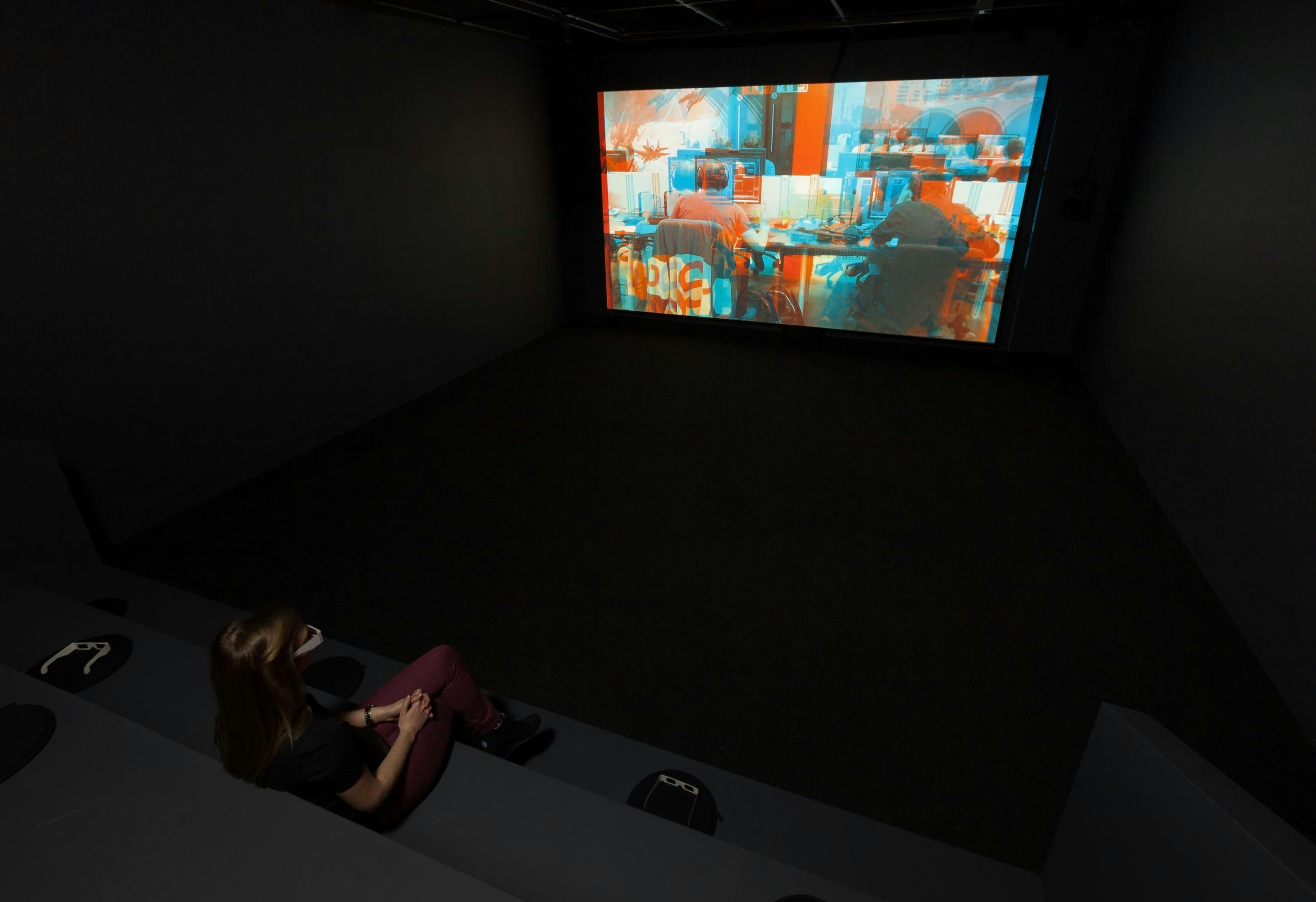
Lucy Raven
2015.04.17 - 06.27
JOSHUA CLOVER
Lucy Raven’s Curtains presents ten still images over the course of fifty minutes. Each is split into the red and blue panes of anaglyph 3D glasses; for five minutes each they sidle toward one another, overlap, coincide, part ways. The motion is hypnotic and implacable. We cannot help but wait for the moment when they match up and grant us the moment of depth and chromatic range—the moment the images, neither more nor less flat than previously, nonetheless feel real. And then they separate, and we are returned to the sense of constructedness, flatness, of the made. The aesthetic.
Surely there is something here of the paired directors about whom Raven has written, Raoul Walsh and André de Toth—both one-eyed, both of whom made 3D movies. Surely Curtains is haunted by Guy Debord’s Society of the Spectacle, which figured its title with an iconic photograph from Life magazine of a cinema audience staring obliquely past us in their 3D glasses. But the film cannot be reduced to a history of spectacles. If it is “about” the dream factory, it is in a more roundabout and nuanced way.
Before that it is about the flatness of images, a world reduced to screens. The stills depict the labour of image-making: VFX techs lodged before monitors, all different, all the same. Raven notes that for all the bleeding-edge technology, Hollywood post-production preserves an industrial kernel from the last century: “global assembly lines run from Los Angeles through Beijing, Chennai, London, Mumbai, Toronto and Vancouver, capitalizing on cheap labour and government subsidies.” After all, the recent shift from Fordist assembly lines to the proletarianization of the cubicle appeared early on in the film industry, with Disney’s famous team of animators (and their famous strike, the first ever in Hollywood, which Raven investigated in her work Lost Disney Production Cels, 1941).
But to see this as a story of exceptionality is to see a world stood on its head. The work resembles all other cubicle labour. Movies, with their glamour and gore, are an incidental resultant; the work product could be advertisements, resolving someone’s utilities bill, analyses of global derivatives markets, summaries of porn preferences. The labour process is the same. What then is the relation between the curious, patient manipulation of Curtains and the global life of digital labour? Both involve staring at screens. Both offer numbing repetition; the poster which appears for Edge of Tomorrow can only be brutally ironic. “Live. Die. Repeat.”
Against all this, that moment midway through each sequence when the flatness of the aesthetic dissolves into the seeming of life, a moment of desire rhythmically conjured and satisfied, a happy ending doled out at five-minute intervals. A kind of eclipse, the image trues itself; as ever in art, the moment of truth is the greatest falsehood. For the aesthetic dimension vanishes just when it is perfected; we think we are seeing the world as it is precisely when it is most confabulated, most an image. And ain’t that the movies?
And ain’t that the world on offer, its real relations hidden behind seemingly solid objects? This is the secret interrogated by Raven’s pendant film, China Town. It traces the production of copper wire from a Nevada mine to a Chinese smelter. Again it is built from still images, this time proliferating, impatient, ratcheting past in eccentric jags somewhere between stop-motion animation and a dysphoric seizure. Taking its place in the supply-chain cinema alongside Alan Sekula’s The Forgotten Space, China Town asks us to see the unity of the world—or rather, to see it again. If Curtains shows us the unification of the wired world which seems to have annihilated distance itself to put all its resources at our fingertips, China Town offers the unification of global logistics that both requires and is required by the technology of the wire—the elusive economic dominations that hold all of us in relation across vast gulfs of continents and oceans. All the miserable work that puts the tech in cinematheque. The big dig behind big digital. These are the processes that Raven cannot escape any more than can we.
Perhaps this is the logic of still images: because all is process, but that process has become unknowable. To claim a whole and fluid grasp would be to counterfeit knowledge itself. We can at least encounter its madeness, its unnaturalness, the fact that it is brought into being by force and necessity. But not our necessity. We’re just the audience. We just work here.